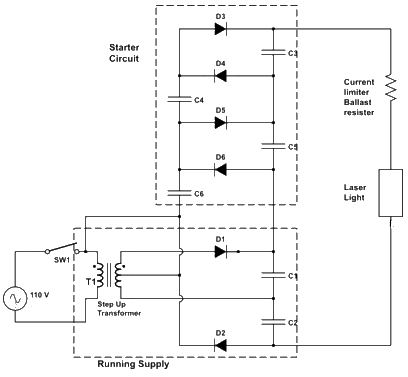Characteristics of GAS Lasers
The lasers having gas as an active medium is called gas lasers. Generally there are three classes of gas lasers.
- Atomic gas lasers. i.e. He-Ne laser
- Molecular gas lasers. i.e. CO2 lasers
- Ion gas lasers. i.e. Argon laser, krypton laser or mix gas lasers
Current flow in gaseous medium
Under normal conditions gas is electrically neutral. That is each atom within the gas has the same number of electrons and protons ensuring that it is neutrally charged and there are no free electrons in the gas mixture. Thus current will not flow in an electrically neutral mixture.
Now in order to induce the current flow, the gas must be ionized. Ions are formed by applying a relatively large amount of energy (voltage) to the gas and so separating electrons from the gas atoms. This result in a gas mixture of atoms, electrons & ions called plasma. Although all gas lasers do not operate in exactly the same manner but their principle of ionization are identical.
The gaseous active medium is held in the tube under relatively low pressure. This tube may be made of Pyrex or quartz for low power lasers or because of gas strength tube is made of beryllium oxide in case of high powered lasers. Around the tube there are two ring shaped metal plates which are connected to DC voltage source. Remember that negatively charged plate is called cathode while positively charged plate is called Anode.
When energy is applied to the laser plasma tube, then the atoms of gas ionizes. This occurs because the positively charged plate strips electrons from the gas atoms, creating ions. These ions then pull electrons from adjacent atoms. Electrons are also supplied to the mixture by negatively charge cathode. The free electrons resulting from ionization process move towards the positively charged anode, while the positive ions move towards the negatively charged cathode.
Remember that a relatively large voltage must be applied to anode and cathode because the electrons are held tightly to the atom. A small voltage will not provide enough energy to break the bond between the positive nucleus and the orbiting electrons. The amount of energy needed to free electrons from each atom is called the ionization potential or breakdown voltage of the gas.
After the ionization potential is reached and the gas is breakdown into positive ions and free electrons, so current flows easily. In fact after ionization has occurred, very small voltages will produce very high currents in the gas.
Now when more and more ions and electrons become available in the gas then current flow increases and less voltage is required to maintain this current flow. This phenomenon is called Negative resistance.
Due to negative resistance the runaway current flows through the tube. To prevent this runaway current flow through the tube there is a current limiting device called ballast resistance.
Power Supply of Gas Lasers
The power supply used with the gas lasers must have three sections, because high voltage is needed to breakdown gas and because of the negative resistance characteristics.
Three different sections of gas laser power supply can be listed as:
Starter or Trigger Circuitry
It must provide a starting pulse of voltage high enough to ionize the gas and produce current carriers.
An operating supply or Running supply
it is capable of providing the current and voltage needed to maintain the laser’s output.
Current limiter
A current limiting device is the current limiter, that will stabilize and hold current at the desire value.
The three sections of power supply can be shown as:

The running power supply provides the voltage and current for operation. This section consist of step up transformer T1 which steps up the input voltage from 110 VAC to 800 VAC. This 800 VAC is affective value. So peak value of 800 VAC is
The diodes D1 and D2 along with capacitor C1 and C2 for a peak voltage doublers circuit that provides the 2240 VDC output used to operate laser. This voltage is present between points A and B on the schematic. This 2240 VDC is the minimum output voltage from the power supply.
- In circuit, the starter is voltage multiplier circuit, where capacitors C4 and C6 charge through diodes D3 and D5. These capacitors charge to increasingly higher voltages until breakdown voltage is achieved. Capacitors C3 and C5 acts as a coupling capacitors. Once the break down occurs then direct current begins to flow in the laser. This DC current path in power supply is through diodes D3, D4, D5 and D6. In effect this removes capacitors C3, C4, C5 & C6 from circuit, eliminating the voltage multiplying function. In other words we can say that when the diodes starts to conduct then voltage across the tube is allowed to drop back to operating voltage i.e. 2240 DC.
- The current limiter is the ballast resistor all the output voltage from the supply is felt across the laser plasma tube because it is an open circuit until the power supply reaches to breakdown voltage. At this point the ballast resistor has no effect on the circuit, however when once breakdown voltage is reached then current begins to flow in the circuit an so the resistance of the ballast resistor limits the current flow.
